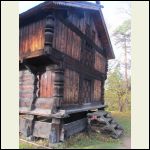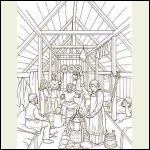|
| Author |
Message |
newf
Member
|
# Posted: 18 Nov 2015 02:15pm
Reply Quote
hello, I am new here love reading the post lots of great info.
I am planning to build a vertical log cabin and I was wondering
if balsam fir is ok to use .? can I mix them in with spruce logs?
and what is the minimum drying time for logs? any info on this type of build would be great . thanks in advance.
|
|
turkeyhunter
Member
|
# Posted: 18 Nov 2015 09:03pm
Reply Quote
I LOVE the vertical log camps/ cottages and hunting camps of Maine .....love the look and they seem to last a long time. We stayed in one a couple years ago that was close to a 100 year old. They used hemlock/white cedar and spruce on some I have stayed in.
|
|
Don_P
Member
|
# Posted: 18 Nov 2015 09:34pm - Edited by: Don_P
Reply Quote
Balsam fir is generally frowned upon in log building circles... but then, they lay their logs down. Mixing species doesn't cause any problem here that I see.
The longer the timbers dry the tighter things will be. The quicker you get them debarked and roughly dimensioned, leave the length long so you can cut out end checking, the faster they will dry. Winter is a good time to do that, the wood will dry below the molding point before springtime temps turn mold back on.
It is never a bad idea to dip timbers in borate to help deter bugs and rot while they are green and then let them dry. I make a dip tank with 2x sides and a plywood bottom ~16" wide x 8" deep. Subfloor glue, caulk, 50 pounds of screws, cheapo garage floor paint. Buy a couple of sacks of soluble boron at a real farm supply and mix 1 lb per gallon of water, let sit/stir until it clears and then start dipping timbers. 3 minutes minimum but longer is better. It has low mammalian toxicity, we treat it much like a salt.
Wandering afield, just historic grist for the mill...
The earliest surviving example I can think of is Greensted Church, I believe also known as St Edmundsbury. There is a great set of drawings done by CW Hewitt in "Historic English Carpentry", I see my copy is loaned out, you can probably get a copy through interlibrary loan or it's about $30 I think. There were some nice joinery solutions in it. If you are looking into historic work I would be researching Viking and Anglo Saxon buildings. In most of that work they were flattening the faces and really hewing out heavy "planks". These were set into, originally the ground, earthfast construction, later a grooved sill timber and capped by a similar plate. This plate contained notches spaced down its' length that accepted tie logs that ran across the building preventing roof spread. Then this notched plate was capped by a mating notched plate log that the rafters sit on. Their longhouses were similarly built. And some had external buttresses logs that propped the walls against the outward push of the rafters. This is the crossroads of time where sills and rafter ties developed.

http://www.academia.edu/6885916/Halls_Houses_and_Huts._Buildings_at_Ribe_Viking_Centr e
stabbur.jpg
| 
longhouse_interior_s.jpg
|  |  |
|
|
newf
Member
|
# Posted: 18 Nov 2015 10:09pm
Reply Quote
thanks for the info . Don , I also heard that you could spray
the logs with a bleach mixture to prevent mold and bugs
|
|
Don_P
Member
|
# Posted: 18 Nov 2015 10:26pm - Edited by: Don_P
Reply Quote
That works on contact but is gone within a day or two, Clorox also begins to pulp the wood, I use it if the mold is winning but that means I've already created a drying problem I shouldn't have. The borate is more of a long term preventative. It stops decay fungi and wood consuming insects but it doesn't prevent molds like bluestain nor does it do anything to insects that bite and spit, like carpenter bees who are not feeding and consuming the wood but are nesting. Last I bought was $50/25 lb sack. I imagine a couple of bags would do it, cheap insurance.
|
|
|

